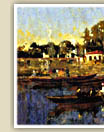
and especially in the work of Kostas Chatzopoulos(1868-1920), Ioannis
Gryparis(1870-1942) and Lambros Porfyras(1879-1932). These three poets
represent three different versions of Symbolism as they adapt the movement to Greek traditions and the Greek psyche - so different from their counterparts in Northern Europe where the movement
was first shaped. In the work of Chatzopoulos, Symbolism is orthodox and Germanic; in that of Gryparis the French influence predominates; and in Porfyras it is transferred to a more original milieu.
Symbolist influence can be traced in the prose of Chatzopoulos, especially in his novel
Fthinoporo (Autumn). Most of the poets of this period were also influenced by Symbolism. Its reception was
facilitated by the prevailing pessimistic, melancholic mood and the feeling of hopelessness, a feeling shared by many poets of the time, perhaps engendered by the national and social crisis.
From the teachings of European Impressionism a new Greek artistic idiom emerged.
Impressionism was the European movement that exerted most influence on Greek art in this period. |
 |

Certain elements of Impressionism can already be seen in the in the work of Georgios Iakovidis
and Symeon Savvidis, whereas the work of Yorgos Chatzopoulos and Odysseas Fokas offers a more distinctive French idiom, which was largely the result of reaction to the infuence of Munich school and Academicism. This paved the way for new pursuits, radically different from those of the past.
Greek light and landscape naturally did not allow a genuine transplantation
of Impressionism to Greece: Greek artists looked to their own traditions to find an individual and personal expression. The new movement and the directions in which
its protagonists led have been severely criticized by academic teachers and critics,
with the exception of Zaharias Papantoniou, who undertook its theoretical defence.
|
 |
